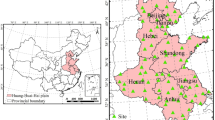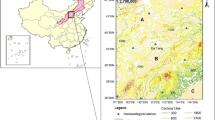Abstract
Waterlogging disasters are one of the most destructive meteorological disasters, which lead to crop yield reduction and cause a great threat to humanity and economic structure. This study presents the methodology and procedure for dynamic risk assessment of waterlogging disasters for maize in Midwest of Jilin Province, China. We took the representative waterlogging disaster years of 1994, 2005, and 2010 as examples, the growth-stage waterlogging index was established to assess the waterlogging disaster hazard by using standard antecedent precipitation index and the relative humidity index. Maize growing data and maize planting area data were combined to assess the waterlogging disaster vulnerability of maize, in which the CERES-Maize model was used to simulate the growth of maize at a daily time step for each grid. Based on the theory of natural disaster risk, the dynamic risk assessment model of waterlogging disaster for maize was built. In this study, the risk indexes were divided into five classes by using an optimal partition method. The grid GIS technology was used to map the spatial distribution of data and the grade of waterlogging disaster risk at a resolution of 5000 × 5000 m. The results show that areas with very low waterlogging disaster risk are mainly located in western and northeastern regions; in contrast, very high and high waterlogging disaster risk levels are mainly located in southern and central regions. Meanwhile, high risk areas at different growth stages gradually spread from the southwestern to the Midwestern and southeastern regions. This study could help the government when they make strategic decisions regarding food security in China, and the method of dynamic waterlogging risk disaster assessment could also be applied for other crops to control and prevent the occurrence and development of waterlogging disasters and reduce their adverse influence.







Similar content being viewed by others
References
Carisi F, Domeneghetti A, Castellarin A (2015) Simplified graphical tools for assessing flood-risk change over large flood-prone areas. Proc IAHS 370:209–215
Cheng X, Sun H et al (2014) Flood disaster risk assessment and spatial distribution characteristics along the Yangtze River in Anhui Province. Jracr 4(4):238–242
Fisher WD (1958) On grouping for maximum homogeneity. J Am Stat Assoc 53:789–798
Guo E, Zhang JQ, Ren XH, Zhang Q, Sun ZY (2014) Integrated risk assessment of flood disaster based on improved set pair analysis and the variable fuzzy set theory in central Liaoning Province, China. Nat Hazards 74:947–965
He JQ, Jones JW, Graham WD, Dukes MD (2010) Influence of likelihood function choice for estimating crop model parameters using the generalized likelihood uncertainty estimation method. Agr Syst 103:256–264
Himmelsbach I, Glaser R, Schoenbein J, Riemann D, Martin B (2015) Reconstruction of flood events based on documentary data and transnational flood risk analysis of the Upper Rhine and its French and German tributaries since AD 1480. Hydrol Earth Syst Sci 19:4149–4164
Hong M, Wang D et al (2015) The variable characteristics and response to climatic factors of the runoff in the downstream areas of the Yellow River under the background of global change. JRACR 5(4):257–263
IPCC (2007) Summary for policymakers. In: Parry ML, Canziani OF, Palutikof JP, van der Linden PJ, Hanson CE (eds) Climate Change: Climate Change Impacts, adaptation and vulnerability. Contribution of working group II to the fourth assessment report of the Intergovernmental Panel on Climate Change. Cambridge University Press, Cambridge
Johnston RZ, Sandefur HN, Bandekar P, Matlock MD, Haggard BE, Thoma G (2015) Predicting changes in yield and water use in the production of corn in the United States under climate change scenarios. Ecol Eng 82:555–565
Jones JW, Hoogenboom G, Porter CH, Boote KJ, Batchelor WD, Hunt LA, Wilkens PW, Singh U, Gijsman AJ, Ritchie JT (2003) The DSSAT cropping system model. Eur J Agron 18:235–265
La N, Lamers M, Bannwarth M, Van Nguyen V, Streck T (2015) Imidacloprid concentrations in paddy rice fields in northern Vietnam: measurement and probabilistic modeling. Paddy Water Environ, 13:191–203
Luo BL, Zhang C, Huang WH (2009) Flooding risk assessment of rice production based on information diffusion in Hunan Province. Chin J Agromet 3:458–462 (in Chinese)
McGuigan K, Webster T, Collins K (2015) A flood risk assessment of the LaHave River watershed, Canada using GIS techniques and an unstructured grid combined river-coastal hydrodynamic model. J Mar Sci Eng 3:1093–1116
Mirzaei M, Huang YF, El-Shafie A, Chimeh T, Lee J, Vaizadeh N, Adamowski J (2015) Uncertainty analysis for extreme flood events in a semi-arid region. Nat Hazards 78:1947–1960
Naderpour M, Lu J, Zhang G (2014) An intelligent situation awareness support system for safety-critical environments. Decis Support Syst 59:325–340
Naderpour M, Lu J, Zhang G (2015) An abnormal situation modeling method to assist operators in safety-critical systems. Reliab Eng Syst Saf 133:33–47
Pachauri RK, Allen MR, Barros VR et al. (2014) Climate Change 2014: Synthesis report. Contribution of Working Groups I, II and III to the fifth assessment report of the Intergovernmental Panel on Climate Change. Intergovernmental panel on Climate Change, IPCC Geneva, Switzerland
Pang XL, Huang CF, Ai FL (2012) Risk assessment on agricultural flood of Northeast China based on information diffusion theory. Chin Agric Sci Bull 28:271–275 (in Chinese)
Przywara G, Stępniewski W (1999) The influence of waterlogging at different temperatures on penetration depth and porosity of roots and on stomatal diffusive resistance of pea and maize seedlings. Acta Physiol Plant 21:405–411
Purba JH, Lu J, Zhang G, Pedrycz W (2014) A fuzzy reliability assessment of basic events of fault trees through qualitative data processing. Fuzzy Sets Syst 243:50-69
Ren BZ, Zhang JW, Li X, Xia Fan, Dong ST, Liu P, Zhao B (2014) Effects of waterlogging on the yield and growth of summer maize under field conditions. Can J Plant Sci 94:23–31
Reynolds JE, Halldin S, Xu CY, Seibert J, Kauffeldt A (2015) Sub-daily runoff simulations with parameters inferred at the daily time scale. Hydrol Earth Syst Sci Discuss 12:7437–7467
Schiermeier Q (2011) Increased flood risk linked to global warming. Nature 470:316
Wallach D, Makowski D, Jones J (2006) Working with dynamic crop models: evaluation, analysis, parameterization, and applications. Elsevier, Amsterdam
Xu L, Zhang Q, Zhou AL, Huo R (2013) Assessment of flood catastrophe risk for grain production at the provincial scale in China based on the BMM method. J Integr Agr 12:2310–2320
Zhang Q, Zhang JQ, Wang CY, Cui L, Yan DH (2014) Risk early warning of maize drought disaster in Northwestern Liaoning Province, China. Nat Hazards 72:701–710
Zhang Q, Cui L, Zhang JQ, Liu XP, Tong ZJ (2015a) Grid based dynamic risk assessment for grassland fire disaster in Hulunbuir. Stoch Environ Res Risk Assess 29:589–598
Zhang W, Li T, Dai MH (2015b) Uncertainty assessment of deterministic water quality model for a combined sewer system with the GLUE method. Desalin Water Treat. doi:10.1080/19443994.2015.1068227
Zhao JF, Guo JP, Mu J (2015) Exploring the relationships between climatic variables and climate-induced yield of spring maize in Northeast China. Agr Ecosyst Environ 207:79–90
Acknowledgments
This study is supported by the National Key Technology R&D Program of China under Grant Nos. 2011BAD32B00-04, 2013BAK05B01 and the National Natural Science Foundation of China under Grant No. 41571491. The authors are grateful to the anonymous reviewers for their insightful and helpful comments to improve the manuscript.
Author information
Authors and Affiliations
Corresponding author
Rights and permissions
About this article
Cite this article
Guo, E., Zhang, J., Wang, Y. et al. Dynamic risk assessment of waterlogging disaster for maize based on CERES-Maize model in Midwest of Jilin Province, China. Nat Hazards 83, 1747–1761 (2016). https://doi.org/10.1007/s11069-016-2391-0
Received:
Accepted:
Published:
Issue Date:
DOI: https://doi.org/10.1007/s11069-016-2391-0




